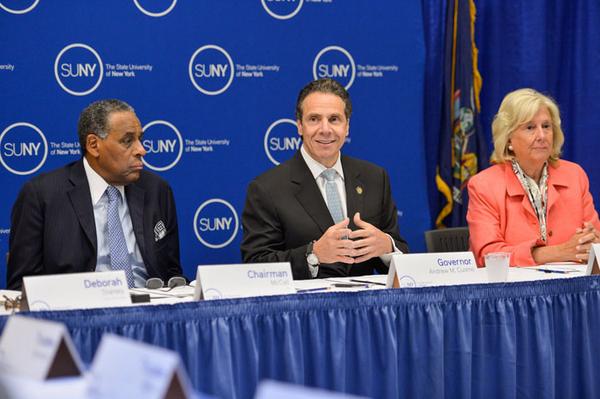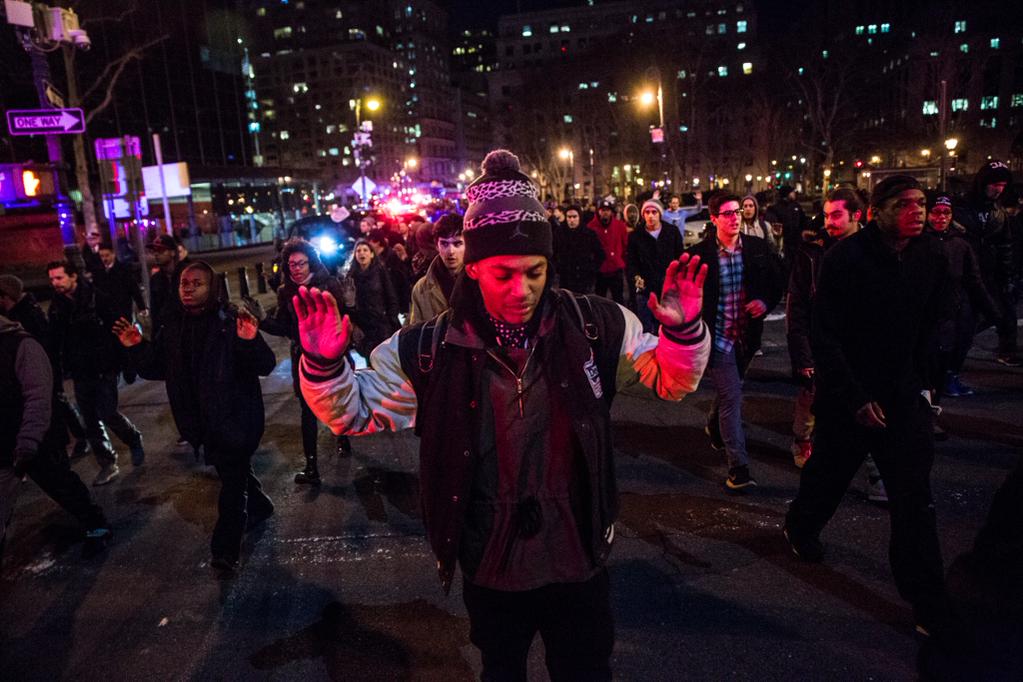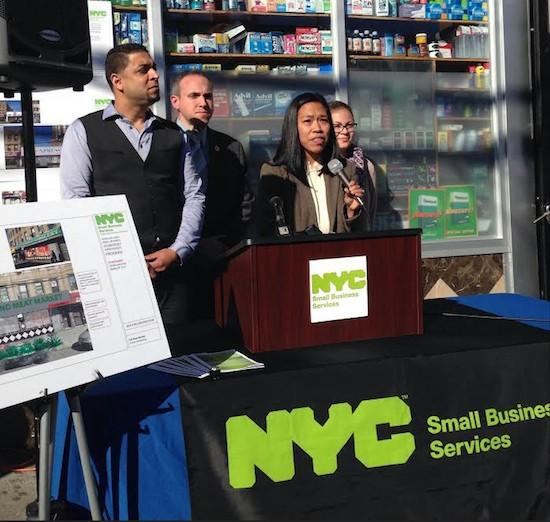New York's Signature College Aid Program Turns 40, But Falls Short of Meeting Needs

Gov. Cuomo making a SUNY-related announcement (photo: @NYGovCuomo)
The Tuition Assistance Program can't keep up with soaring tuition costs without comprehensive reform.
Total student loan debt in the U.S. is currently more than $1 trillion, surpassing credit card and auto-loan debt. This debt is not only threatening young graduates' ability to fully participate in the economy, but also suffocating too many families and middle-aged adults. According to the New York Federal Reserve, 30-year-old student debt holders are less likely to own a home and more likely to delay their own retirement.
Sixty percent of New York college graduates – nearly 3 million residents – incur debt, with a total of $73 million and an average amount of more than $25,000. To make matters worse, median wages for people between the ages of 25 and 34 have fallen in every major industry except healthcare.
Unfortunately, New York State has responded by cutting funding and increasing tuition. In fact, over the last two decades, average tuition and fees at public four-year colleges in New York have risen 127 percent while students continue to foot the bill. Since 2008, New York State cut nearly $2 billion to higher education. Tuition at the State University of New York (SUNY) has increased by $1,550 and at the City University of New York (CUNY) by $1,700. Those costs will continue to grow as a result of the NY SUNY 2020 "Rational Tuition Bill," which is scheduled to raise tuition at public colleges by $300 annually for five consecutive years.
Meanwhile, New York State's signature college aid program – the Tuition Assistance Program (TAP), which turned 40 this year – has remained grossly inadequate, leaving too many New Yorkers behind.
After years of cuts to this $1 billion program that helps over 300,000 students annually, there are a number of important policy reforms that the state needs to consider. Fortunately, New York State Assembly Higher Education Chairwoman Deborah Glick is holding a public hearing in Albany on Wednesday, December 10 to review TAP.
While tuition continues to surpass the maximum TAP award of $5,165, universities are left to fill the gap for the most at-need students. This costs the universities tens of millions of dollars every year, which takes away from other vital needs. It's time for the State to increase the maximum TAP award to at least $6,500 to match public tuition and to take some of the debt burden off of New York families.
In addition, the fight over the NY DREAM Act has gone on long enough. It's time to allow all young people – including our undocumented youth – the opportunity to pursue their dreams. Governor Cuomo must include funding for undocumented youth to access state financial aid – including TAP – in this year's budget. The cost would be less than 2 percent of the total TAP budget and would not take away from other students who currently receive the award or will do so in the future. The Office of the New York State Comptroller estimates that extending aid to the state's 8,000 undocumented youth would enhance the earnings of individuals and grow the state's tax revenue.
The State needs to make it easier for part-time students to access aid and pursue a degree by eliminating the requirement that students attend college full-time for a year before becoming eligible for Part-Time TAP. From 1980 to 2012, the number of part-time community college students in New York increased by 193 percent, yet the State has been non-responsive to their growing need. What's more, even students who are eligible for Part-Time TAP can only receive six semesters of aid, which contributes to the college completion challenge.
This isn't just a problem for younger New Yorkers: TAP has historically left out lower-income working adults and must open access for all, regardless of age. Its current award schedule is based on the first year a student received an award, meaning that if a student first enrolled in a college in 1998 and received the maximum TAP award ($4,125 at the time), and that same student re-enrolled today, he or she would still only be eligible for the 1998 award level, notwithstanding subsequent increases to tuition or TAP.
Despite the many reforms needed to bring the program into the 21st century, the State did make two improvements to the program last year. For the first time in 14 years, it finally increased the award, adding $165. In addition, the final budget included a no-brainer reform to make orphans and wards of the State eligible for the $5,165 maximum award available to "dependent" students instead of the $3,025 maximum award available to "independent" students.
The state budget must reflect the values of New York residents. As Governor Cuomo begins to prepare his Executive Budget for next year, we must continue to remind him that high and preventable student loan debt caused by high tuition and inadequate state aid are not New York values.
***
Kevin Stump is Leadership Director for the Roosevelt Institute Campus Network and former chair of the Coalition to Reform TAP
***
Have an op-ed idea or submission for Gotham Gazette? Email executive editor Ben Max: This email address is being protected from spambots. You need JavaScript enabled to view it.
Dear Educators: Please scrap your lesson plans

Protesters on Wednesday evening in New York (photo: William Alatriste)
Good morning. I'm incredibly appreciative that school is in session today in New York City and that you're there to care for our children. I thank you for the leadership you show and the responsibility you embrace every day. I wish I was going to be leading a classroom today, but I'm not, I left teaching a couple of years ago. So yes, I'm a quitter and you should take the thoughts I offer with whatever skepticism you deem appropriate.
Now I run this news publication. I try to educate the public about New York politics and government; and I continue to closely follow and care deeply about what happens in our schools.
I'm writing to ask that you scrap your lesson plans for the day - and probably tomorrow too.
I know the panic that this notion can instill, bumping anything a day or two often means making even more difficult an already insurmountable task of trying to fit everything in before the end of the marking period. I've been there. But, this is really important.
Today is a day for social studies in virtually every classroom in every school in this city. It's a day to study our society. It's time for current events.
Whether or not you spent some of Wednesday afternoon or evening following the decision of a Staten Island grand jury and its aftermath; and whatever you think about that decision and what has been said and done since; it's incredibly important that we make sure students know what is going on and provide them with space to process. It's important for us adults too, of course. I hope you agree.
I understand what I'm getting at here - bumping whatever you have planned for today (and maybe tomorrow) and talking with students about controversial political things that center around race and crime and protest - might be making you pretty uncomfortable. As it would. And you may have already rolled your eyes at me, which I completely understand. But, bear with me, please.
If you (or your students) haven't been following the circumstances around the July 17 death of Eric Garner on Staten Island and the case of Police Officer Daniel Pantaleo, who the grand jury decided not to indict relative to Garner's death, (or even if you have), here is a timeline of key developments courtesy of The New York Times.
Because it never makes sense to ask a teacher for a last-minute change in plans as dozens of students head for your door without offering support, there are a few other resources linked below, including video of Mayor Bill de Blasio and President Barack Obama commenting in response to the grand jury's decision and a few articles and opinion pieces.
Yes, I'm asking that you talk with your students about what is happening in New York City (and elsewhere). About race and policing and protest and justice. You don't have to have all the answers, or even most of them. You don't have to give your opinions, or even have them. You don't have to tolerate racism or hate in your classroom. But, man oh man do we have some very 'teachable moments' here. Moments for students to ask questions, talk about personal experiences, share what they might have seen or heard last night as New Yorkers marched all over Manhattan in protest.
We shouldn't pass this moment up - we should talk about these things - even in biology or algebra.
As Chancellor Carmen Fariña wrote in a memo to Department of Education staff on Wednesday morning that you may or may not have seen: "As adults, we know that there are many positive ways to respond to complex situations that result in greater insight and understanding; current events can be a great learning experience for the entire school community."
Clearly doing even a little bit of what I'm suggesting could be very tenuous, even dangerous, in many classrooms, I'm not naive. Obviously you know your students and class dynamics better than anyone else and will use your discretion. But, perhaps there's space for at least some discussion around what almost all students are surely at least somewhat aware of.
Maybe it's just the basics of the Garner incident and Pantaleo case, what happened last night, and where things stand: with federal and internal NYPD investigations underway and several more chapters likely to come in this tragic saga.
Maybe it's a discussion of whether protesters should be allowed to block traffic or of what students think police officers' biggest challenges are in doing their jobs. Maybe it's just journaling and conversation in pairs or small groups about something relevant.
You probably don't need me to tell you any of this, and forgive me if you're annoyed - I know that often the last thing teachers want to hear is other people telling them what to do in their classrooms. I'm simply hopeful that New York City classrooms will be the best places for learning that they can be, today and every day.
Thank you.
***
A brief sample of resources (note: much of the above and below is maturity and age-dependent):
The New York Times
De Blasio Reacts as Mayor and a Father (includes video of the mayor's remarks)
The New York Times
Officer Told Grand Jury He Meant No Harm to Eric Garner
4+ mins of President Obama discussing the issues at play in response to the Staten Island ruling Wednesday afternoon (YouTube via The White House)
Capital New York
Justice department to investigate Garner's death
Newsday
Arrests on Brooklyn Bridge as Protesters Fan Out Across City
DNAinfo
83 People Arrested as Thousands Protest Eric Garner Decision
Newspaper Editorial Boards:
The New York Times
A Search for Justice in the Eric Garner Case
The New York Daily News
The Eric Garner 'chokehold' grand jury decision has the earmarks of a gross miscarriage of justice
The New York Post
No indictment
New York Newsday
Eric Garner Case Decision Defies Belief
Something different, but very relevant (probably only appropriate for high school and beyond):
NPR
#CrimingWhileWhite Opens A Prism On Police And Race
***
by Ben Max, executive editor, Gotham Gazette
@TweetBenMax
email me: This email address is being protected from spambots. You need JavaScript enabled to view it.
Jobs Task Force Report Shows Progress, But Much More Must Be Done For Young Adults

Small Busniess Services Commissioner Torres-Springer (photo: @SBSNeighborhoods)
Although New York City's unemployment rate has plummeted in recent months, economic recovery remains little more than a rumor for the more than 300,000 New Yorkers between 18 and 24 years old who are not in school and out of work or stuck in low wage jobs—a number comprising 35 percent of all New Yorkers in that age range. For this group, the shortcomings of New York City's workforce system bear depressing similarity to the drawbacks that marred their experiences in public education. Both offer too little relevance to their current challenges and long-term needs.
The workforce system's disconnection from economic development investments and priorities, and the failure of many related programs to deliver market-relevant education and training, do not serve young adults who need to build skills and gain experience.
This past spring, Mayor Bill de Blasio convened the Jobs for New Yorkers Task Force, a 30-member committee of noted corporate executives (including JobsFirstNYC board member Greg Hambric of Modell's Sporting Goods), educators, philanthropists, union leaders, city officials and nonprofit service providers, to develop strategies to strengthen the city's workforce system and help workers to secure well-paying jobs in high demand careers. The Task Force was assigned to make recommendations to spend the City's nearly $500 million workforce development budget more effectively. The recently released Career Pathways: One City Working Together, fulfills this charge.
A bid to shift the system's focus from quick placement into low wage jobs to emphasis on careers, the scope of Career Pathways is unprecedented. The recommendations would shift how the City spends more than $150 million annually and impact operations within no less than eight city agencies, including the Department of Education and the City University of New York, as well as hundreds of business owners and nonprofit organizations. The task force identified two major organizing principles to enable this change: Industry Partnerships and Career Pathways. While both strategies offer promise, the report leaves many crucial questions unanswered.
Industry Partnerships would serve as intermediaries between employers and service providers. But the report does not address the structures or authority of these partnerships, nor does it identify what role nonprofits will play within this structure. Career Pathways align and coordinate education and training programs toward career progression. Exactly how the City will manage this complex transition from rapid attachment to career development is not discussed in the report.
Also unclear is how the plan would change the career trajectory of those young adult New Yorkers who lack the skills to compete for jobs that pay living wage or stuck in low-wage jobs.
One option for the City to consider is work being done by organizations like JobsFirstNYC to develop sector-based partnerships that may also be well-positioned to support certain constituents like young adults. The Young Adult Sectoral Employment Project, created by JobsFirstNYC and supported by private philanthropy, could serve as a primer for developing a broader array of industry-specific partnerships.
Given the scale, complexity, and duration of the challenges facing young adults in the labor market, we urge the City to formalize a position with respect to this important group and identify a vehicle that can help more of these young adults connect to training and educational opportunities, as well as to employers.
JobsFirstNYC has proposed the creation of a network of Youth Opportunity Centers in the 18 communities that are home to more than half of the 35 Percent. Because so many of these young adults are unlikely to seek assistance outside their communities, we must bring help to them.
The Youth Opportunity Centers—operated by community based organizations that are known and trusted by residents—could serve as the locus for a range of services to reconnect young adults to education, help them to develop career plans, and link them to training, internships, apprenticeship programs, and jobs. Similar models across the country, such as the Los Angeles YouthSource Centers, have proven highly effective at connecting more young adults to education and employment.
While the City's thoughtful and long-overdue reassessment of its approach deserves credit, it is much easier to release a report than to actually see through a years-long effort of systems change. As the Mayor's Office of Workforce Development and key workforce agencies—including the NYC Department of Education, Department of Small Business Services and Human Resources Administration—begin to implement the recommendations of the Task Force, we urge them to engage a constellation of other actors who have experience in developing industrial partnerships (better known as sector partnerships), and career pathways training. Likewise, partners in this work must include nonprofits who will deliver services on the ground, and customers themselves.
The recommendations made by the Jobs for New Yorkers Task Force carry potential for real progress toward increasing the incomes of low-income New Yorkers, and represent an important start toward creating a workforce system worthy of the City it serves. But the real work has only just begun, and we hope the City will engage the full range of actors necessary to address such an ambitious agenda. At JobsFirstNYC, we remain focused on advancing economic opportunity for all young New Yorkers.
***
Louis Miceli is Executive Director of JobsFirstNYC, a nonprofit intermediary focused on connecting young adults to the economic life of New York City.




